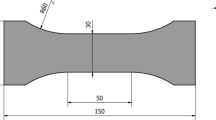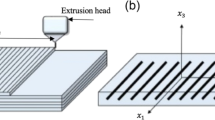Abstract
Polypropylene (PP) is a relatively new material in fused deposition modeling (FDM) technology. The main feature of this material is its ability to significantly elongate under applied load, unlike any other thermoplastic material used in FDM technology. Not much research has been conducted on this FDM material so far, hence, the subject of this paper is the investigation of printing parameters’ influence on PP tensile properties. Targeted parameters are layer height, infill density, and the orientation of raster lines, resulting in four different manufacturing regimes. To have a better insight into the experimental results, the data are analysed using ANOVA statistical method with Tukey HSD post hoc test. Obtained statistical results have proven the printing parameter’s influence on tensile results, emphasizing the influence on elastic modulus. Here, Tukey test results show the maximal number of homogeneous subsets evidencing that all printing parameters have an influence on elastic modulus values.
Similar content being viewed by others
References
I. Gibson, D. Rosen and B. Stucker, Additive Manufacturing Technologies: 3D Printing, Rapid Prototyping and Direct Digital Manufacturing, Springer, New York (2015).
P. Jakovljević, Đ. Dihovični, I. Bijelić, D. Kreculj and N. Ratković Kovačević, Experiences in 3D printing applied in education, Structural Integrity and Life, 22 (2022) 43–47.
M. Aleksandrović, N. Ratković Kovačević, D. Kreculj, Đ. Dihovični and P. Jakovljević, Making a 3D printer of delta configuration using open-source project, Structural Integrity and Life, 22 (2022) 125–130.
M. Jin, C. Neuber and H. W. Schmidt, Tailoring polypropylene for extrusion-based additive manufacturing, Additive Manufacturing, 33 (2020) 101101, DOI: https://doi.org/10.1016/j.addma.2020.101101.
I. I. Ailinei, S. V. Galaţanu and L. Marşavina, Influence of deposition direction on vibration characteristics of 3D printed ABS test specimens, Structural Integrity and Life, 22 (2022) 25–28.
M. Doshi, A. Mahale, S. K. Singh and S. Deshmukh, Printing parameters and materials affecting mechanical properties of FDM-3D printed parts: perspective and prospects, Materials Today: Proceedings, 50 (2022) 2269–2275, DOI: https://doi.org/10.1016/j.matpr.2021.10.003.
A. K. Sood, R. K. Ohdar and S. S. Mahapatra, Parametric appraisal of mechanical property of fused deposition modelling processed parts, Mater. Des., 31 (1) (2010) 287–295, DOI: https://doi.org/10.1016/j.matdes.2009.06.016.
M. Kaveh, M. Badrossamay, E. Foroozmehr and A. H. Etefagh, Optimization of the printing parameters affecting dimensional accuracy and internal cavity for HIPS material used in fused deposition modeling processes, J. Mater. Process. Technol., 226 (2015) 280–286, DOI: https://doi.org/10.1016/j.jmatprotec.2015.07.012.
A. Chalgham, A. Ehrmann and I. Wickenkamp, Mechanical properties of FDM printed PLA parts before and after thermal treatment, Polymers, 13 (2021) 1239, DOI: https://doi.org/10.3390/polym13081239.
T. A. Lin, J. H. Lin and L. Bao, Polypropylene/thermosplastic polyurethane blends: mechanical characterizations, recyclability and sustainable development of thermoplastic materials, J. Mater. Res. Technol., 9 (2020) 5304–5312.
N. H. Lazim and N. Samat, The influence of irradiated recycled polypropylene compatibilizer on the impact fracture behavior of recycled polypropylene/microcrystalline cellulose composites, Adv. Manuf. Polym. Compos. Sci., 40 (2019) E24–34.
H. A. Maddah, Polypropylene as a promising plastic: a review, American Journal of Polymer Science, 6 (1) (2016) 1–11, DOI: https://doi.org/10.5923/j.ajps.20160601.01.
Y. H. Chen, Z. Q. Wu, Q. Fan, S. Yang, E. C. Song and Q. Y. Zhang, Great toughness reinforcement of isotactic polypropylene/elastomer blends with quasi-continuous phase morphology by traces of beta-nucleating agents and carbon nanotubes, Compos. Sci. Technol., 167 (2018) 277–284.
E. Matei, M. Rapa, A. A. Andras, A. M. Predescu, C. Pantilimon and A. Pica, Recycled polypropylene improved with thermoplastic elastomers, Int. J. Polym. Sci. (2017) 7525923, DOI: /https://doi.org/10.1155/2017/7525923.
D. Tripathi, Practical Guide to Propylene, Rapra Technology Ltd., Shawbury, U.K. (2002).
O. S. Carneiro, A. F. Silva and R. Gomes, Fused deposition modeling with polypropylene, Mater. Des., 83 (2015) 768–776.
N. Kumar, P. K. Jain, P. Tandon and P. Mohan Pandey, Experimental investigations on suitability of polypropylene (PP) and ethylene vinyl acetate (EVA) in additive manufacturing, Mater. Today Proc., 5 (2) (2018) 4118–4127.
J. Liao, N. Brosse, A. Pizzi, S. Hoppe, X. Xi and X. Zhou, Polypropylene blend with polyphenols through dynamic vulcanization: mechanical, rheological, crystalline, thermal, and uv protective property, Polymers, 11 (2019) 1108, DOI: https://doi.org/10.3390/polym11071108.
G. Gao, J. Xu, G. Tang and Z. Liu, A survey of the influence of process parameters on mechanical properties of fused deposition modeling parts, Micromachines, 13 (2022) 553, DOI: https://doi.org/10.3390/mi13040553.
A. Milovanović, Z. Golubović, T. Babinský, I. Šulák and A. Mitrović, Tensile properties of polypropylene additively manufactured by FDM, Structural Integrity and Life, 22 (3) (2022) 305–308.
C. Bilsland, A. Barrow and T. Ben Britton, Correlative statistical microstructural assessment of precipitates and their distribution, with simultaneous electron backscatter diffraction and energy dispersive X-ray spectroscopy, Materials Characterization, 176 (2021) 111071, DOI: https://doi.org/10.1016/j.matchar.2021.111071.
S. L. Sing, W. Y. Yeong, F. E. Wiria and B. Y. Tay, Characterization of titanium lattice structures fabricated by selective laser melting using an adapted compressive test method, Experimental Mechanics, 56 (2016) 735–748, DOI: https://doi.org/10.1007/s11340-015-0117-y.
S. Rohde, J. Cantrell, A. Jerez, C. Kroese, D. Damiani, R. Gurnani, L. Di Sandro, J. Anton, A. Young, D. Steinbach and P. Ifju, Experimental characterization of the shear properties of 3D-printed ABS and polycarbonate parts, Exp. Mech., 58 (2018) 871–884, DOI: https://doi.org/10.1007/s11340-017-0343-6.
D. W. Zimmerman, A note on preliminary tests of equality of variances, British Journal of Mathematical and Statistical Psychology, 57 (2004) 173–181, DOI: https://doi.org/10.1348/000711004849222.
J. Hartung, D. Argac and K. H. Makambi, Small sample properties of tests on homogeneity in one-way ANOVA and Metaanalysis, Statistical Papers, 43 (2002) 197–235, DOI: https://doi.org/10.1007/s00362-002-0097-8.
A. Koh and R. Cribbie, Robust tests of equivalence for k independent groups, British Journal of Mathematical and Statistical Psychology, 66 (2013) 426–434, DOI: https://doi.org/10.1111/j.2044-8317.2012.02056.x.
P. D. Berger, R. E. Maurer and G. B. Celli, Multiple-comparison testing, Experimental Design with Applications in Management, Engineering, and the Science, 2nd Edition, Springer (2018) 107–154, DOI: https://doi.org/10.1007/978-3-319-64583-4_4.
Acknowledgments
The authors would like to thank the support from European Union’s Horizon 2020 research and innovation program (H2020-WIDESPREAD-2018, SIRAMM) under grant agreement No. 857124, and the Ministry of Education, Science, and Technological Development of the Republic of Serbia by Contract No. 451-03-68/2022-14/200105 from 4th of February 2022.
Author information
Authors and Affiliations
Corresponding author
Additional information
Aleksa Milovanović is a research assistant at the Innovation Center of the Faculty of Mechanical Engineering, Belgrade, Serbia. His research is oriented on the application of fracture mechanics aspects on additively manufactured components.
Zorana Golubović is a senior research associate at the Faculty of Mechanical Engineering, University of Belgrade, where she received her Ph.D.. Her research interests include additive manufacturing, polymers, biomaterials, and material characterization.
Snežana Kirin is a Full Research Professor at the Innovation Center of the Faculty of Mechanical Engineering, Belgrade, Serbia. Her research interests include risk management, statistics, risk-based analysis and R&D projects.
Tomáš Babinský is a Ph.D. student at IPM, Brno, Czech Republic. His subject field is focused on degradation mechanisms during fatigue, especially on the role of surface relief evolution on fatigue crack initiation and fatigue life in nickel superalloys.
Ivo Šulák is a postdoc at the Institute of Physics of Materials (IPM), Brno, Czech Republic. He received his Ph.D. from the Brno University of Technology (BUT) in 2019. His research interest includes high-temperature degradation mechanisms, additive manufacturing, and superalloys.
Miloš Milošević is a scientific advisor at the Innovation Centre of the Faculty of Mechanical Engineering in Belgrade. He has 10 years of research experience related to additive manufacturing, rapid prototyping, prototype development, innovation funding, and R&D projects.
Aleksandar Sedmak is a Professor Emeritus at the Faculty of Mechanical Engineering, University of Belgrade. His field of expertise covers material science and engineering, fracture mechanics, structural integrity, and welding science, as well as additive manufacturing.
Rights and permissions
About this article
Cite this article
Milovanović, A., Golubović, Z., Kirin, S. et al. Manufacturing parameter influence on FDM polypropylene tensile properties. J Mech Sci Technol 37, 5541–5547 (2023). https://doi.org/10.1007/s12206-023-2305-5
Received:
Revised:
Accepted:
Published:
Issue Date:
DOI: https://doi.org/10.1007/s12206-023-2305-5




